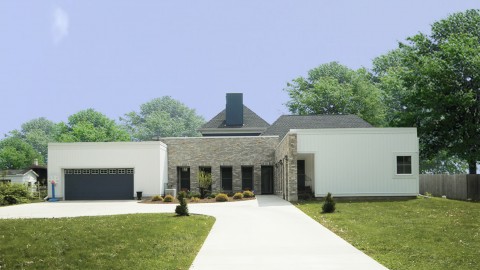Questions for the architects: 3D Design Studio
3D Design Studio is an award-winning Chicago-based architecture and design firm. CAC had the pleasure of working with co-founders A. Melinda Palmore and Darryl G. Crosby during the creation of 2016’s “50 Designers, 50 Ideas, 50 Wards” exhibition.
by Nikki Snodgrass, Media Relations Manager
The work of 3D Design Studio has included interior spaces for buildings like the Goodman Theater, and creatively designed buildings including the Newsome Home and ROE Technology. Their vision for CAC’s “50 Designers, 50 Ideas, 50 Wards” exhibition is called “MATH: Making Architecture That Heals.” It asks this question: “How can we bring all the vitality and community of a thriving neighborhood business district under one roof?” In the South Shore community, where solid housing stock is in strong supply, 3D Design Studio is addressing just that issue.
“MATH: Making Architecture That Heals” presents a modest-sized commercial building in which the first floor contains a retail shop that sells products designed by the businesses located in office floors above. The building’s communal outdoor spaces can be activated with events in all seasons, bringing energy to the street, while collective spaces at the podium level house trainings on entrepreneurship and other activities meant to cultivate local business know-how.
We spoke with Melinda and Darryl to learn more about their design approach, their inspirations and their understanding of our city’s urban environment.
1. What project have you enjoyed working on most?
No project in particular can be singled out, because the work we’ve been involved in has been very diverse. The most fulfilling projects have all had a common thread. Each has changed, or had the ability to change, the trajectory of people’s lives because of the mission of the organizations that were planning them.
For instance, designing a project that redefines the image of the urban “storefront” church, or helps bridge the digital divide for a community that could potentially be left behind, or working with an organization that has a vision for solving homelessness, or even working to provide a safe place and universal space for a child with disabilities. These types of projects have a positive impact on people within their communities, and the ability to give them hope.
2. What has been significant about participating in the “50 Ideas, 50 Designers, 50 Wards” exhibition with CAC?
It’s a really good feeling to be selected by architects you admire and respect, ideating solutions to some of the real issues that our city faces. “50 Ideas, 50 Designers, 50 Wards” has enabled us to extend ideas that we conceived for the Chicago Architecture Biennial to a larger audience. We hope the exhibition will open the eyes of Chicagoans and city leaders to the fact that there is no need to seek talent from other places to produce good and insightful architecture.
3. How would you describe the thinking behind the “MATH: Making Architecture That Heals” concept and what did you hope to convey?
We’ve always sought solutions that are unique to a given problem being presented to us. What has always revealed itself through this approach is the need for a “Big Idea,” or in other words, a concept that gives us a narrative to follow. For instance: The DuSable Museum of African American History’s “A Museum in Motion,” the proposed museum wing about the Great Migration; or “Swelling Architecture,” which is a universal design prototype that allows people with disabilities to age in place. “MATH: Making Architecture That Heals” continues this tradition of design.
Architecture can promote growth and healing in communities where vacant lots and buildings stand as visible signs of the wounds inflicted. Our MATH Technology Center provides an environment where learning, teaching and collaboration reactivate a community. The five major elements of outdoor collective/performance space, upper outdoor terrace, interior collective space, classrooms and a pop-up for use as an economic engine all provide a path to healing. The collective spaces are like a salve wrapped by architectural bandages to accelerate the healing process. The intentionally small footprint is designed to facilitate collaboration and promote use.
4. How would you define architecture and design, and how does that definition inspire your ideas?
By definition, architecture is simply “the art and science of planning and building structures.” For us, architecture is a critical practice that endeavors to recover and discover the mystery of the ordinary. Everyday materials take on new meaning, reveling in their power to create new symbols and emotions. Architecture, at its best, captures the soul of the client and elevates the designer to new heights of understanding about the importance of their craft.
5. What is one project you have not worked on but would like to in the future?
While we have been blessed thus far, it would be an awesome feat to design a legacy project, which we define as a project that has an impact on a global audience and is left behind for prosperity. They represent the aspirations and ideals of a culture from the viewpoint of that generation. Examples might include an Olympic pavilion, a presidential library or an American embassy. It would be a humbling experience to share with the world the design process we are developing and to add a voice to that dialogue.
6. How has Chicago been an inspiration for your work?
It has been a blessing to practice within a city that has a legacy of pushing the envelope for architecture, the city where concepts like, “Make no little plans,” “Less is more,” and “Form follows function” originated. Living in Chicago is like residing in a three-dimensional library of architectural movements and styles. And while we realize that existing projects were responses to a different set of problems and client situations, we still have the option to physically visit a structure to admire or study if we choose.






